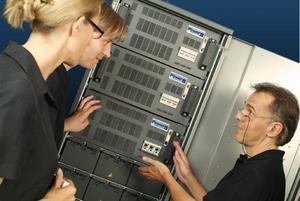In this month’s engineering services cost model, Davis Langdon Mott Green Wall reviews the principles of data centre design and look at the implications for the services costs
Demand for data centres slowed after the dot.com crash of 2000, but facilities in London are now reported to be bursting at the seams, with rack space at a premium.
It has been estimated that demand for data centres is growing at about 30% per year. A recent survey found most operators in the UK are already close to capacity, and the sector is set for significant long-term growth. This is due to the greater use of corporate websites and the insatiable demand for internet services, the development of high band-width services, and of organisations looking to outsource their data processing work to reduce costs.
The cost model concentrates on co-location centres, which provide serviced space for rent with guaranteed uninterrupted operation of tenants’ equipment and access to multiple, primary optical fibre networks.
Co-location centre requirements are very specific. A resilient, secure data centre is based on interdependencies. Like a jigsaw, where every piece matters, each system and process in construction of a data centre must be analysed so there is no one point of weakness to compromise its operation.
A typical data centre has at least 20 major mechanical, electrical, fire protection, security and other systems, each of which has subsystems and components, and all of which must be concurrently maintainable and/or fault-tolerant in order for the entire site to be considered the same. This means providing redundancy of plant to maintain system operation, and care must be taken to ensure this investment is not applied to the wrong parts of the system, resulting in ineffective expenditure.
One of the most common sources of confusion in relation to the design of data centres is the definition of reliability and availability (ie a system’s forecast downtime). With the explosive growth of the internet comes increased demand for computer hardware reliability. Information technology customers expect availability of 99.999%, but it is doubtful that even the most thoroughly designed infrastructure system can support such a figure.
A tiered classification for site infrastructure functionality has been developed to provide a common standard. This is summarised in Table 1 (overleaf). Under this system, measured availability ranges from 99.671% for tier 1 systems to 99.995% for tier 4 systems.
Co-location centres are either tier 3 or 4, and it is important the degree of risk (and hence the levels of protection and redundancy) is balanced with cost and that the design satisfies the operational requirements of the building and the business objectives of the operator.
Using Figure 1 as a backdrop, there are several key design issues, the first of which is the site. From a services point of view, there are three core business determinants: location, power and communications.
The location should be as free as possible from natural and man-made risks (ie flooding, adverse weather conditions, proximity to potentially polluting sites etc), and close to major clients.
There should be a reliable, high capacity electrical power supply or supplies. The nature and number required will depend on the levels of reliability and resilience to be provided. Not every part of the national grid is capable of delivering these requirements, and constraints on the available power supply may have significant effects on cost and programme.
Proximity to good, diverse high band-width fibre links, from multiple tier 1 suppliers, is key in providing the diversity that ensures the resilience essential to operators and tenants.
Conversion of warehouse, industrial and office space allows facilities to be completed quickly, but there is a finite supply of suitable buildings in the right locations, so purpose-built projects are becoming the norm.
Phasing of the development, allowing expansion without affecting the operation of the completed space, is important to the viability of a scheme. There are two main approaches to providing flexibility in the services installation.
- Central distribution: where the complete primary distribution network is installed as part of the initial phase, but plant is only brought on line in response to tenant demand. Although the services disruption is minimised, the initial investment is high.
- Modular services: by providing local distribution networks encompassing all critical services including primary and secondary distribution, services are only installed to areas on demand. This minimises up-front investment and improves the degree of resilience through the creation of stand-alone systems. Disadvantages include the need to link the modules and the greater complexity of installation work.
There are key prerequisites for construction of the data centre itself that have an impact on the design of the services.
- Ideally a freestanding building with a boundary perimeter and vehicle access control, allowing good perimeter security.
- Equipment rooms distanced both horizontally and vertically from internal water services and areas such as toilets and kitchens.
- Secure reception and site perimeter access infrastructure with visitor parking away from the building and ideally no car parking beneath.
- Plant/storage space for standby generation, dual utility entry points with diverse physical routing, UPSs, fire suppressant cylinders, equipment configuration before installation, admin areas etc.
- Appropriate width and load capacity access route from exterior to equipment rooms.
- Use of smaller segmented equipment rooms with fire separation between and communications/power distribution, air-conditioning, fire suppression etc that is resilient to the loss of another equipment room.
In terms of communications within the building, good practice requires:
- Separate communications termination rooms to allow different providers access without the need for entry into other areas.
- Servers with multiple network interface cards for dual (high speed) local area network (LAN) connection resilience.
- Dual LAN switches, patching and cabling. Switches and routers that support hot swap of redundant power and network interface cards are desirable.
- Comprehensive network monitoring and alert facilities, which may include external monitoring.
Electrical services
Traditionally, the primary cost unit for a co-location centre was floor space. Now it is electrical power.
The availability, size and security of the power supply is the major selling point of a co-location centre. Power loads of 800-1,000W/m² are available, but many operators are looking to increase this to 1,200-1,500W/m². This standard represents the maximum theoretical load if the technical areas were filled to capacity. In practice, below-optimum use of rack space and diversity of server operation mean this limit may not be approached.
Development of blade servers, allowing more muscle to be packed into existing racks, has contributed to the increasing power demands. Whereas a typical rack has a load of about 2kW, a rack full of new blade s

















